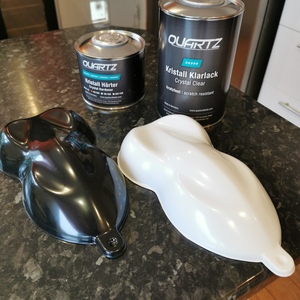Hi guys,
I'm slowly getting together what I need to try out a few topcoat options (I've got Rustin's Plastic coating, some water and solvent based polys, melamine lacquer) with a view to making some test pieces to see how they fare as possible guitar finishing solutions (not just how good the final result looks and how tough it is, but also how they are to work with, how compatible they are with stains and sealers, etc).
For the moment I'm focusing on hand applied, because I don't really have either the gear or the location for spraying. A situation I imagine some others on this forum share.
When the London Hackspace reopens I may look into spraying (we definitely have a humungous compressor, the space or a member probably own a gun or two and we have a semi external space (known as "the cage") which would probably be good to paint in from a point of view of ventilation (though I'd probably want some sort of collapsible mini spray booth to keep paint in and dust out), but all that is for the future.
For now, hand applied it is.
The intention is to post my results here.
But first, I was wondering if anyone here already had experience of such finishes and advice on how to go about it. Brush preferences? Brushing technique? sanding between coats? what grades of sanding for flat and finish sanding? Pitfalls to watch out for?
Might be one for Mark’s finishing course he’s still completing.
I'm seeing information like this as (hopefully) useful support information for the finishing course. I'm trying to find solutions which are readily available in the UK at reasonable prices (or at worst are reasonably importable like the Keda Dyes I got, especially if people did a group buy to save on shipping).
It's not just the individual components, it's compatibility, Take Rustin's as an example, it's known to be tough and be able to produce a great finish (there are also some very dodgy results out there), but the documentation suggests it's not very compatible with dyes and sealers (but I've found a number of historical posts on forums that suggest it actually works fine with a lot more products than the Rustin's official position would suggest).
I've found a number of historical posts on forums that suggest it actually works fine with a lot more products than the Rustin's official position would suggest
Try and get hold of a sample and try on some scrap?
I have too many guitars...said no one in the world..ever!
Try and get hold of a sample and try on some scrap?
That's what this is all about!
I have a starter pack right next to me. I'll be trying it out on bare wood, stained wood (I have Keda dyes and stunning stains shots), stained with a sanding sealer over it, not sure what else.
Well I for one am very interested to see what you come up with. I don’t have any place to spray either so we’re in the same boat, good luck!
Practice on scrap...
I'm slowly getting together what I need to try out a few topcoat options (I've got Rustin's Plastic coating, some water and solvent based polys, melamine lacquer) with a view to making some test pieces to see how they fare as possible guitar finishing solutions (not just how good the final result looks and how tough it is, but also how they are to work with, how compatible they are with stains and sealers, etc).
@jonhodgson As much as I would love to help with what you are suggesting, I haven’t used any of these products (I am assuming they are rattle cans?). I advice I normally give is to test test test and test some more to find out the nature of how a product performs but you have already preempted that. I would love to see your results of your tests though, try and vary the tests and do them as scientifically as you can (in recording the results). Design and creative a test plan in a table format and record what happens. Try grain filling some of your test wood and leave other bits open, try different types of wood too. Materials from rattle cans is normally quite thin so lots of thin coats applied is much better than thick coats (that will just run and make a mess), apply it as evenly as you can and be consistent across all tests. Also try using sanding sealer on some test pieces before the array of topcoats and some without. Use the manufacturers instructions for drying times and try to keep the temperature and humidity consistent to minimise blooming and other defects. Paint in a clean environment away from dust, grease, dirt and other detritus. Oh and especially anything silicone based such as WD40 or car interior polishes etc (nightmare). These are the deadly enemy of paint product, they cause a whole range of paint defects, “fisheye” being a major one. Keep everything as clean as possible. When everything is dry and cured fully (you may have to wait for some time with some products), see how different products sand and what grades of paper you use and whether you sand wet or dry. A sanding test plan may be used. After that, see how each one polishes up and with different polishes, a polishing test plan could be used.
Failing all of that, just paint some stuff and see what happens.
Sometimes, when testing new paints, I use sprayout cards or speed shapes to test how paint products react or to test application techniques.
Speed shapes are curved, 3D objects usually in the rough shape of a car, to show how different angles affect how the light reflects back at you from different parallaxes. The pictures below show some blank, unpainted ones I’ve just bought. They are fun to paint, especially when testing the cool colour shifting chameleon paint I’ve just ordered, for example.
Let me know how you get on and have fun.
Make guitars, not war 🌍✌️🎸
Ive tried melamine lacquer when I first started making instruments, a long time ago. It wears well but dries hard so is not ideal for acoustics as it stiffens the wood making it less responsive in transferring mechanical energy to sound waves. The difficult part is getting it to stick to the wood as it can peel off after time. I found that a compatible sanding sealer is essential to prime the surface first. Some people call this the "ground". Like any finishing you need a mirror surface first before lacquer is applied, then I suggest a fine brush with thin layers and don't over brush because the dried appearance will be different to the wet.
Some people call me a tool, others are less complimentary. Tools being useful things.
No rattle cans in this batch (though I'll try a rattle can acrylic sealer), these are going to be brush applied.
@jonhodgson Oh sorry, my mistake. You can still use a test plan though if you wanted to. The only other finishing products I’ve used are a handfulll of oils. I’ve used Finishing Oil, Danish Oil and Tru Oil. Tru Oil is my absolute favourite.
Make guitars, not war 🌍✌️🎸
Thanks
I've done a quick test piece of melamine lacquer so far, just enough to start to get an idea of its characteristics, but your info will be very useful.
What sort of sealer did you use?
The sanding sealer I used was the same make as the lacquer, it was Craft Supplies which was bought over by Turners Retreat a few years ago. I think their current brand is called Chesnut.
Some people call me a tool, others are less complimentary. Tools being useful things.
Chestnut is the melamine lacquer I have. Can you recall if you used their cellulose or acrylic sealers?
I'll be watching for your test results worh interest, I'm doing a similar thing but in a much limited way. I've carved a bit of ash, sanded to 320 grit and applied grain filler and stain. The grain filler is Osmo water based wood filler, the stain in Crimson's stunning stains. Thesanded to 400 grit and sprayed with lacquer, I got eight coats on it before my rattle can ran out yesterday. I've got no control over the temperature and humidity (7°C and 83% yesterday) in my garage. Can anyone suggest how long I should let the lacquer cure before I try polishing it.
Cool.
Was that a full can? It seems a little excessive for what doesn't look like a particularly big piece.
I've got some ash and maple plank offcuts coming to test on (I'm just getting started in this game so I don't have any offcuts from previous projects).
Since it's not clear filler I assume you filled then stained? How did that affect the staining?
No, it wasn't a full can, there wasn't a lot in it.
The piece of ash is an offcut from the body that I've got ready for finishing.
Yes, I raised and sanded the grain, then filled the grain and sanded again before staining. The Osmo is available in several wood colours, the maple/birch that I used is a fairly close match to my ash so I didn't see any huge difference on the stain between filled or not. I did dig a little hole in the test piece and filled it before staining. If you look at the photo about 1/3 way in from right and bottom, it shows up and is quite obvious.
I see you've got solvent based poly, then you can try a wipe-on poly finish. I've used this method with great success a number of times and I'm currently using it on my new project, the wannabee Exotica.
You can make your own wipe-on by mixing 1 part poly with 1 part mineral spirits. Use paper towels to wipe on 1 thin layer per day or until fully dry, wiping in the direction of the centre line. After some layers the wood will be saturated and the poly will start to build. Give it a rub with a Scotch Brite pad between coats to take of nibs, dust specs, moths, spiders, wipe marks and the like and to key the surface for a next layer. Keep adding layers until a nice shine appears and you are pleased with the result.
Let it cure for a week or so, rub with the Scotch Brite pad and buff with some fine compound. Be gentle, don't rub through...
You can achieve a satin sheen and even a fairy high gloss if you apply enough coats.
And be sure to dispose of the used rags and gloves by letting them dry outside or soaking them in a bucket with water, they can be prone to self combustion....... Don't want you to burn down your house, now do we...?
Measure once, cut straight away and maybe you're lucky......
I'm going to try the aquacoat grain filler (it's quite pricey, but it's the only clear one I can find). Another possibility might be adding microballoons to some carrier, which I've seen Chris from Highline Guitars talking about in a video (though I wish I could find it again to see what he put them in).
I would guess that the issue with filling before staining is if you want to use the sandback technique to highlight grain and figuring? That relies on the stain sinking deeper into those parts of the wood.








